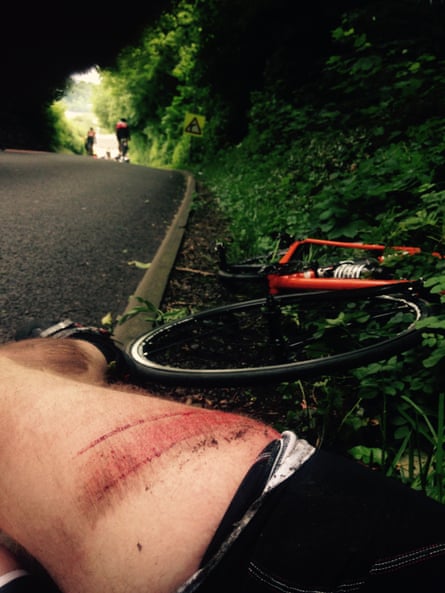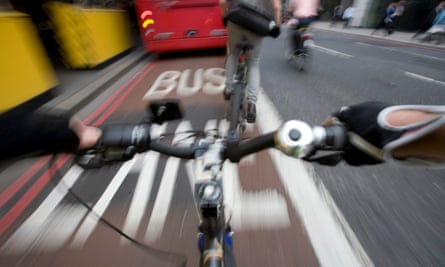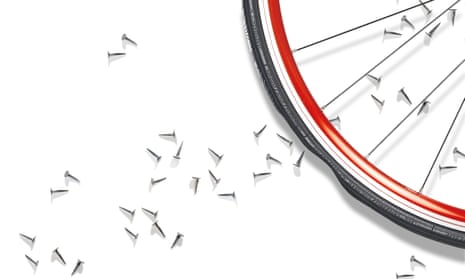On 14 June 2015, Alec James was taking part in the Velothon Wales, a 90-mile mass bike ride on closed roads through countryside near Cardiff. The 28-year-old press officer, a keen cyclist, had invited along some London friends and was particularly proud to show them the region where he grew up.
But his day ended early. “I was about 30 miles in, on a fast downhill stretch, and I saw one rider on my left go down,” James says. “I moved to avoid him and started to slow. Then my front tyre blew out and I went over. I rolled with the bike for a good few yards, bashed my head, breaking the helmet. I was doing about 30mph. I got deep lacerations on my leg. I couldn’t walk properly for a week.”
After he struggled to his feet, James found a drawing pin in his front tyre, then saw a number of other tacks scattered on the road, at a point seemingly chosen to cause the most danger.
A fortnight before this, police in Brighton had issued a warning about wires strung between trees on a popular bike track through woodland, saying two such hazards had been spotted in as many days. A week earlier, in Dorset, a rider suffered cuts after hitting 15 strands of fishing line stretched across a cycle path in a country park.

In the same week, several riders taking part in Redhill Cycling Club’s 70th anniversary road race, on back roads in the Surrey countryside, suffered punctures after drawing pins were scattered on the route. No one was hurt, but that was mainly down to luck, says Adrian Webb, the club’s chairman: “You can guess how dangerous it can be if you have an 80-man peloton and someone punctures unexpectedly. These guys have got slick tyres pumped up very strongly for a race – there’s every chance a tyre can explode. If a rider comes off, there could a mass pile-up.”
Such incidents remain rare, and any such physical threat to cyclists is tiny when compared with the danger from other motor vehicles, especially lorries. One of the many paradoxical elements about cycling in Britain is that it is both far safer than many people think – numerous studies have shown it is many times more likely to lengthen a lifespan through increased exercise than shorten it – but notably more perilous than it could be.
Annual government road casualty figures for 2014, released last week, show the number of seriously injured riders rose 8.2% against the year before, a bigger increase than that in the number of cyclists. In London, in particular, the focus is on the danger posed by lorries, especially construction trucks. On 24 June, thousands of protesting cyclists brought the busy road junction at Bank to a halt after 26-year-old consultant Ying Tao was crushed by a tipper truck two days earlier. She was the eighth cyclist killed in the city in 2015, seven of whom died in incidents involving lorries, six of the victims women.
Another paradox is that even as cities such as London and Bristol are, finally, building segregated bike lanes, proven to be the best way to prevent such deaths, the tone of the debate around cycling has arguably become more polarised and poisonous than ever. Some campaigners worry that the sabotage incidents are linked to a public and media narrative in which cyclists are demonised equally as both anarchic lawbreakers and smug, humourless killjoys, sausage thighs squeezed into unsightly DayGlo Lycra.
The debate around cycling occasionally bears comparison with the treatment of so-called societal outgroups, according to Dr Ian Walker, a psychologist at Bath University. One of his experiments to research attitudes towards cyclists involved riding around his home town wearing a long brunette wig with an electronic distance gauge attached to his bike, to see whether drivers gave female cyclists more overtaking space than men. They did, even when the “woman” was 6ft tall and, for the drivers who happened to look in their rearview mirror, surprisingly hairy.

“What you see in discourses about cycling is the absolute classic 1960s and 1970s social psychology of prejudice,” he explains. “It’s exactly those things that used to be done about minority ethnic groups and so on – the overgeneralisation of negative traits, under-representation of negative behaviours by one’s own group, that kind of thing. It’s just textbook prejudiced behaviour.”
This is played out in the media, on television and radio and, most virulently, via social media and website comments. Under a Daily Mail story last week about Ying’s death, the most-recommended reader comment until it was deleted read: “Why not ban cyclists? They don’t pay road tax.”
This is a particularly pervasive point, and one that ignores the fact that “road tax” – a car-based fund set aside for highway construction – was scrapped in 1937. Vehicle excise duty, its replacement, is based on emissions, meaning cyclists, if liable, would be zero-rated anyway.
Other comments under the piece surmised that such deaths happen because of rampant cyclist lawbreaking, notably jumping red lights. Again, this doesn’t bear scrutiny. An analysis of police statistics found a failure to stop at a red light or stop sign was a factor in just 2% of serious adult cycling incidents; in contrast, drivers were deemed solely to blame about two-thirds of the time.
Lawbreaking is one of the difficulties of the debate for cyclists. The average person on a bike is arguably no more likely to break a law then their peer in a car. However, when they do so it’s more obvious, less normalised. People notice a cyclist pedalling through a red light, whereas speeding – which 80% of drivers admit to doing regularly – is often ignored, despite the immeasurably greater human cost this causes.
Chris Boardman, the Olympic track cycling champion who is now policy adviser to British Cycling, recalls appearing on a recent episode of BBC Radio 4’s You and Yours to discuss whether cyclists should be obliged to take out insurance, a discussion prompted in part by an incident where a pavement-riding cyclist struck a young child. This premise lacked context, Boardman argues: “When you put it into perspective, there’s 36 people killed on pavements by cars, buses and lorries every year – that’s just on pavements – versus about one every three years from a cyclist. It’s ludicrous the programme was even on. Nobody seems to feel obliged to look at any facts.”
Elsewhere over recent years, there has often not been any attempt at balance, even in generally sober parts of the media. Several years before anyone thought of stringing wire across Brighton woodland, Times columnist Matthew Parris half-jokingly advocated a similar idea in a piece titled: “What’s smug and deserves to be decapitated?”

In November 2013, the Spectator ran as its cover story a long rant by Rod Liddle at cyclists, describing them as oversensitive lawbreakers who deliberately hold up traffic while wearing “pompous little pointy plastic hats”. Even the Observer had an article in April of the same year by a regular columnist, Kevin McKenna, calling cyclists a scourge, complete with jokes about middle-class bike-riding fops and their “cous cous packed lunches”.
BBC Radio Kent, meanwhile, ran a phone-in show about road safety last week under the banner: “Should cyclists be banned in cities?”
A recent twist on this narrative is the idea of a two-wheeled versus four-wheeled “war” on the roads, typically illustrated by dramatic cyclist helmet camera footage. “Many road rage incidents have been prompted by the ongoing war between motorists and cyclists,” boomed a promotional tweet last week from ITV’s This Morning programme. “Whose side are you on?”
Boardman is scathing about such hyperbole, not least because cyclists and drivers are very often the same people – British Cycling data shows 90% of its members also own cars.
“You’ve got 2% of vulnerable road users versus 98% in two tonnes of steel,” Boardman says. “How can you possibly have a war? I think that’s called a massacre. What could a cyclist possibly do to somebody in a car?”
He is, however, wary of connecting this media narrative with the idea of an increase in attacks and sabotage against cyclists: “There’s about 250,000 assaults on the streets a year. If we’re going to accuse other people of taking things out of context, we need to not do that. There are always going to be idiots and people who are evil or just plain stupid.”
Others profess to see the hint of a connection, at least locally. Mark Strong, a transport consultant and cycling advocate in Brighton, says the debate about bikes in his home city has been increasingly toxic ahead of the wire-trap incidents, partly inflamed by the recently ousted Green-led council’s introduction of new bike lanes and parking restrictions.
“There is an element of legitimisation towards dislike of cyclists from the attitudes of the press and politicians,” he says. “It’s almost an official endorsement to be anti-cyclist. And for everyone who thinks it’s now OK to shout at a cyclist, at the tip of the bell curve there will be somebody who think it’s OK to stretch wires across bike paths.”
Rachel Aldred, a Westminster University sociologist who studies transport issues, argues that British cyclists suffer because, unlike in countries such as the Netherlands and Denmark, bikes are seen as frivolous, compared with the serious, adult business of driving. She says: “It’s as if you’re doing something you shouldn’t be doing on the roads, almost like you’re playing in the street and getting in the way of the traffic, like you’re a child. There’s also this dual way you can be stigmatised as a cyclist – it was historically seen as something for people with no choice, but now it’s seen as something for people who have a choice. It’s a leisure or play thing that they shouldn’t be doing in this inappropriate place.”
Aldred has also studied the environment cyclists face on the road, and her findings are alarming. In a pioneering paper published this month she finds cyclists experience on average one “very scary” incident involving another road user every week. Female riders suffer disproportionately more, thought to be because drivers are less patient with their slower average speeds.

Do toxic anti-cyclist comments in newspapers or on social media contribute to this road environment? It’s impossible to prove. But some believe this is the case. “I’d be very surprised if that’s not happening,” says Walker. “It is acceptable to sit in a pub and say things like: ‘Bloody cyclists, we should run them off the road.’ Or to write things that are, literally, calling for murder. You can’t do that with other groups.”
In 2013, Walker led a study that saw a co-researcher sent on to the roads on a bike in seven different outfits, with a gauge measuring the space drivers gave him overtaking. Four outfits made him look like a cyclist of varying experience, while three had bright yellow waistcoats with written messages. One read: “Novice cyclist: please pass slowly.” Another: “Polite: please slow down.” And finally: “Police: camera cyclist.”
The data for 5,700 overtakes showed just one garb made an appreciable difference to driver behaviour: the one saying “police”. Here, the average passing distance was notably bigger, while the proportion of vehicles who passed very near the bike was significantly lower. In contrast, the tabard saying “polite” saw almost twice as many potentially dangerous passes.
The lesson seems clear: drivers are perfectly able to distinguish between different types of rider, and to read the message. But rather than adjusting their driving to the cyclist’s apparent vulnerability, the only real trigger for them to take proper care is a possible legal sanction.
Will things change? Bike campaigners hope London’s new network of segregated cycle “superhighways”, now being built, will increase the number of riders, and act as an example to other cities. Cycling as everyday transport, and cyclists whose progress is separated from that of motor vehicles, will, they hope, drain the poison from the debate.
Such tangled considerations remain far from the mind of James, now back at work and again on the bike, though with a pedal-shaped chunk out of his thigh from his high-speed fall in South Wales: “It was the worst bike crash I’ve had by far, and all the more upsetting as it was nothing that I did. Perversely, I was quite lucky with the injuries I had. If this kind of sabotage continues, someone will get killed.”

Comments (…)
Sign in or create your Guardian account to join the discussion